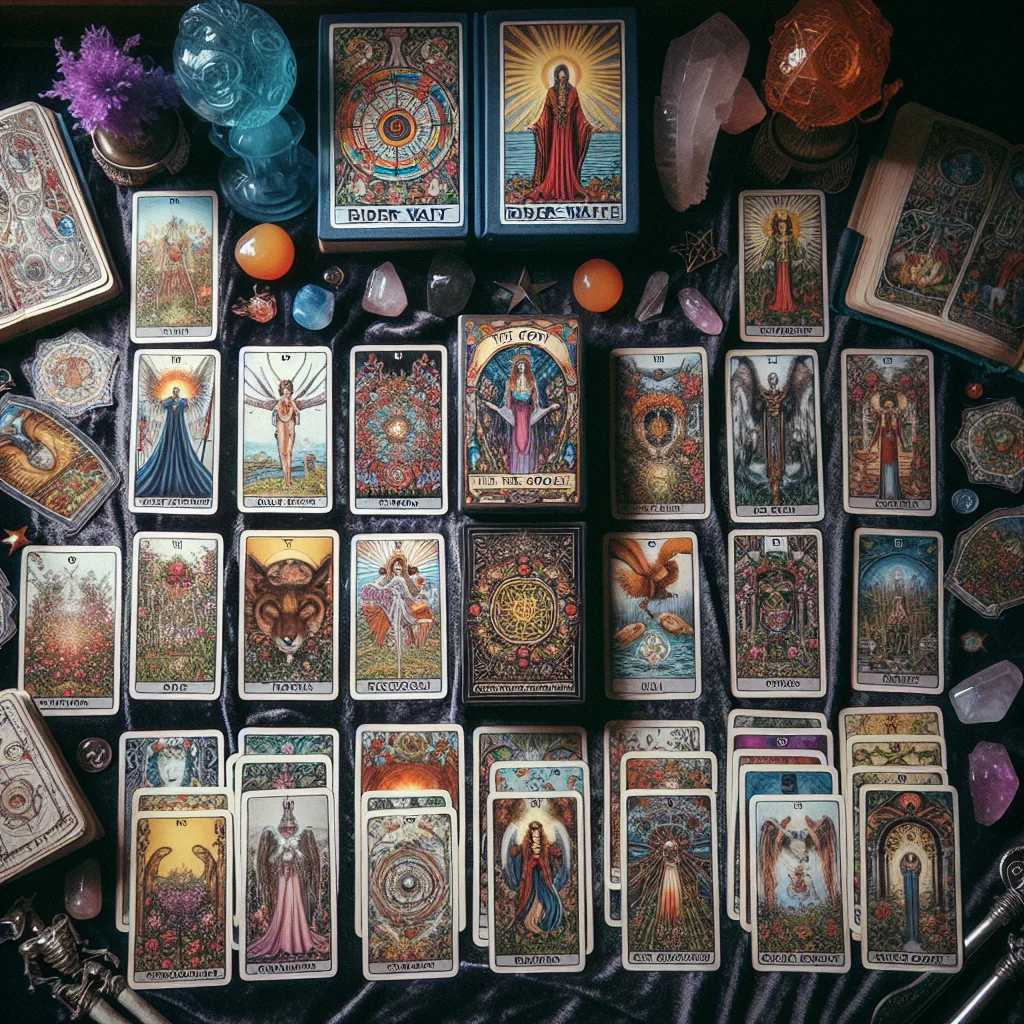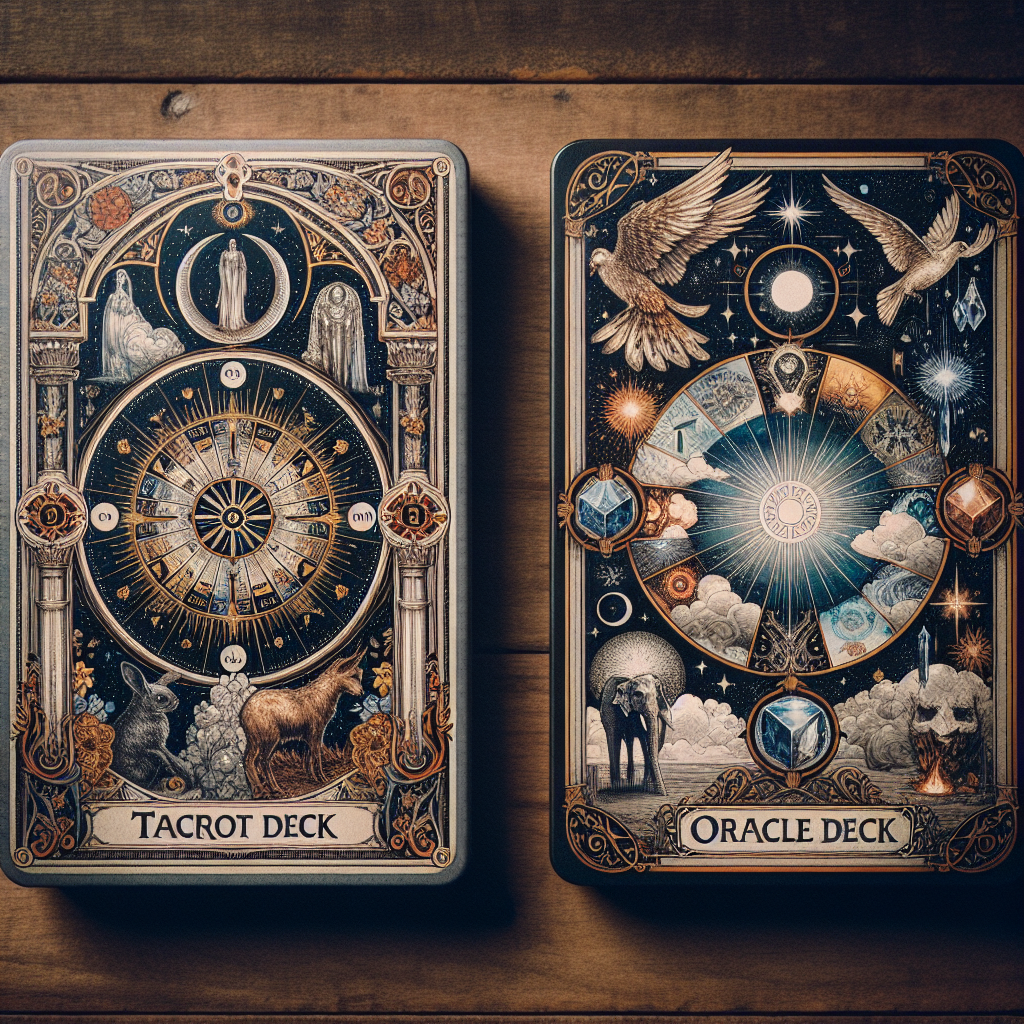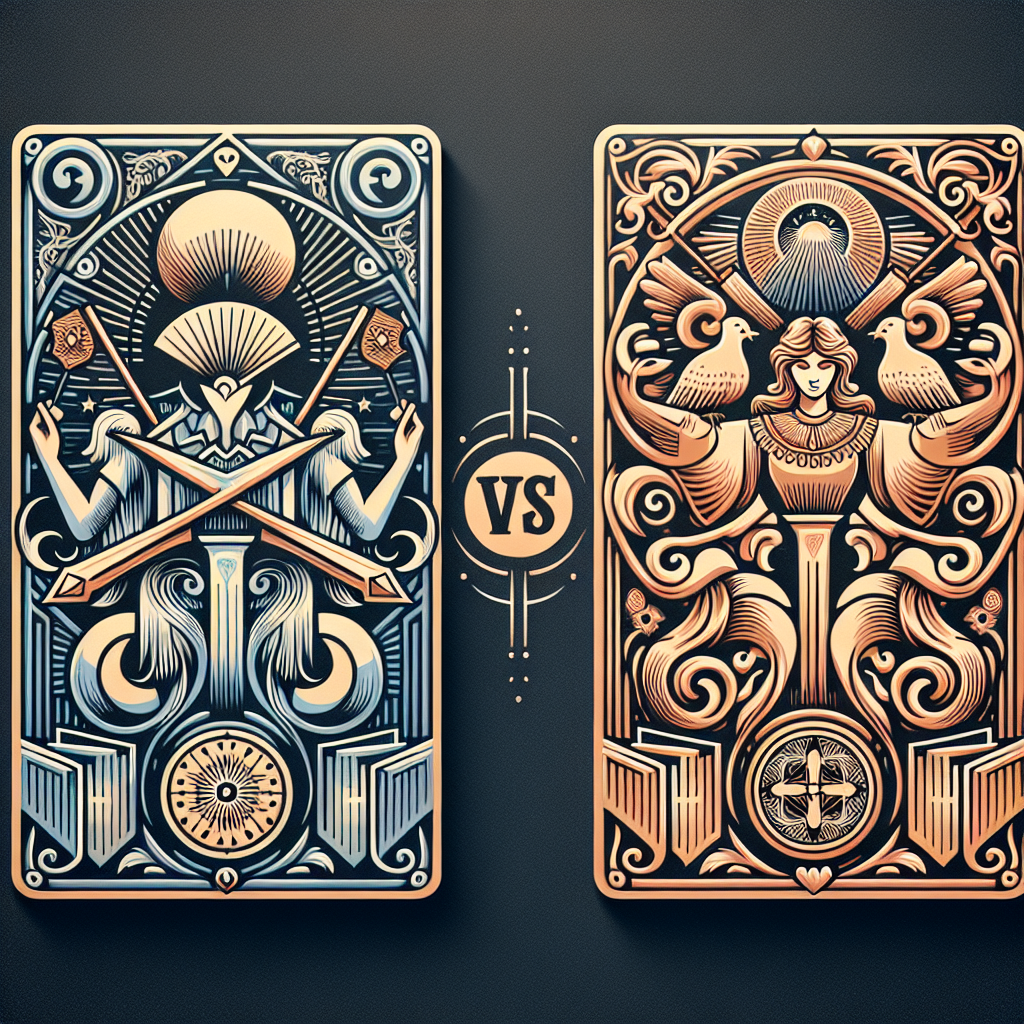As an Amazon Associate I earn from qualifying purchases.

Tarot cards have been used for centuries, not just for fortune-telling, but also as tools for reflection and personal growth. At their core, tarot decks consist of 78 cards, typically divided into the Major Arcana (22 cards) and the Minor Arcana (56 cards). The Major Arcana cards represent significant life themes and lessons, while the Minor Arcana delve into day-to-day events, with four suits similar to regular playing cards.
The history of tarot cards is as enigmatic as the images depicted on them, with their use in divination dating back to the mid-15th century in various parts of Europe. Initially, these cards were used for games, and it wasn’t until the late 18th century that they became associated with mysticism and magic when they were adopted by occultists and mystics. The practice gained momentum in the 20th century, with the popularization of the Rider-Waite-Smith deck, which remains one of the most recognizable tarot decks in the world.
In contrast, oracle decks are a more free-form type of card deck used for similar purposes of divination and insight but without the structured format of tarot. Unlike tarot, which has a fixed number of cards and traditional suits, oracle decks can have any number of cards with various themes, images, and concepts. These decks are as diverse as their creators’ imaginations, providing a wide range of tools for personal introspection and guidance.
Oracle decks offer a canvas of possibilities that appeal to individuals looking for a more intuitive and personal approach to card reading. Their fluid nature allows users to draw from a deck that may resonate more deeply with their current life circumstances or personal preferences. Consequently, oracle decks have witnessed an increase in popularity; a survey of divination practitioners reported that more than half incorporated oracle cards into their practice, alongside or in place of traditional tarot decks.
The usage of tarot and oracle decks transcends mere fortune-telling; for many, these cards serve as a reflective mirror, presenting visual symbolism that can unlock subconscious thoughts and offer clarity on life’s complex situations. As more people turn to spirituality and self-help tools, tarot and oracle cards have found their way into mainstream culture, showing up in bookstores, online platforms, and popular media, indicating a thriving interest in the mystical and the metaphysical.
Sure, here is an SEO optimized article title in H1 HTML tags:
“`html
What’s the Difference Between Tarot and Oracle Decks? A Comprehensive Comparison
“`
And here is a paragraph providing an introduction to the topic:
Tarot and Oracle decks are powerful tools used for personal introspection, spiritual guidance, and divination, but they differ significantly in structure, tradition, and usage. Tarot decks follow a specific system of 78 cards, including the Major Arcana and Minor Arcana, that have remained relatively consistent since their inception in the 15th century. Each card has a standard meaning, allowing for universal interpretation across various decks. In contrast, Oracle decks are more fluid, with no set number of cards or specific structure, affording creators the freedom to craft unique decks with individual meanings and themes tailored to their vision. While Tarot requires learning a broader system of symbolism, Oracle decks can be more intuitive and personal in their messages. For an in-depth exploration of how these two divinatory tools contrast in their approaches to unlocking the mysteries of the self and guiding decision-making, continue reading as we delve into the details of Tarot versus Oracle decks.
Tarot vs Oracle Decks: Uncovering the Distinctions
Tarot and oracle decks, while often interchanged or grouped together, are distinctive tools used for personal insight and divination. Each serves a unique purpose and offers various approaches to guidance and reflection.
Tarot Decks: Structure and Tradition
Tarot decks are composed of 78 cards, divided into the Major Arcana (22 cards) and the Minor Arcana (56 cards). The Major Arcana cards represent significant life themes and lessons, while the Minor Arcana cards reflect day-to-day events and are further divided into four suits (usually Cups, Pentacles, Swords, and Wands). Each suit contains fourteen cards: ten numbered cards and four court cards (Page, Knight, Queen, and King).
The structured nature of tarot stems from its deep historical roots, dating back to the mid-15th century. Tarot decks follow a relatively standardized system, heavily influenced by traditions such as the Rider-Waite-Smith deck, which set the foundation for the symbolism and meanings attributed to the cards. This structure provides a universal framework for interpretation, making it accessible and recognizable for practitioners across the globe.
Oracle Decks: Flexibility and Diversity
In contrast, oracle decks offer a more fluid and open-ended form of divination. Unlike tarot, there is no set number of cards, nor are there specific suits or archetypal themes that must be included. Oracle decks are created based on the vision of the deck’s creator, resulting in a wide range of themes, from angels and animals to elements and affirmations. Because of this, oracle decks can be deeply personal and diverse, with each deck carrying its own unique energy, symbolism, and suggested usage.
Practitioners often choose oracle cards for their intuitive messages and the ability to tailor readings to a specific situation or question. The lack of a conventional structure allows both readers and seekers to rely more on intuition and personal interpretation, which some find to be a more freeing experience than using the traditional tarot system.
Combining Tarot and Oracle Decks in Practice
Many modern users employ both tarot and oracle decks in their practices, finding that the two can complement each other in readings. The tarot’s structured insights can be enhanced by the oracle’s personalized messages, offering a well-rounded perspective. This combination allows for detailed readings that tap into both the shared wisdom of the tarot’s archetypes and the more specialized guidance from oracle cards.
Choosing Between Tarot and Oracle Decks
When deciding between tarot vs oracle decks, it ultimately comes down to personal preference and the type of wisdom one is seeking. Tarot may be best suited for those who enjoy tradition, structure, and the depth of learning that comes with a system that has evolved over centuries. On the other hand, oracle decks may appeal to those looking for a more personalized, flexible, and intuitive experience.
The Growing Popularity of Cartomancy
The popularity of both tarot and oracle decks has seen a significant increase over the past few years, as more people turn to these tools for self-reflection, spiritual growth, and decision-making support. According to a report by MarketWatch, the “Mystical Services Market” is expected to grow substantially, with a particular rise in interest surrounding tarot readings and similar practices, demonstrating the ongoing appeal and relevance of these ancient yet evolving modalities.
1. What is the main difference between Tarot and Oracle decks?
The main difference between Tarot and Oracle decks lies in their structure and tradition. Tarot has a specific format of 78 cards, which includes 22 Major Arcana cards and 56 Minor Arcana cards. Oracle decks, on the other hand, do not have a set structure and can vary in the number of cards and the themes they encompass. Tarot has a more standardized interpretation system, while Oracle cards are more open to individual interpretation.
2. Can beginners use Oracle decks or should they start with Tarot?
Beginners can use either type of deck, and the choice often depends on personal preference and intuition. Some find Tarot’s structure helpful in learning and understanding the cards’ meanings, while others may resonate more with Oracle decks’ freedom and ease of interpretation.
3. Is one better for personal reflection versus fortune-telling?
Both Tarot and Oracle decks can be used for personal reflection and fortune-telling. Tarot’s traditional meanings and symbolism can provide depth for such practices, while Oracle’s fluidity can offer more personal and direct insight. It’s about what aligns best with the purpose and preference of the reader.
4. Are Tarot decks more accurate than Oracle decks?
Accuracy in readings comes more from the reader’s intuition and skill rather than the type of deck used. Both Tarot and Oracle decks can provide accurate readings; what matters is the connection between the reader, the cards, and the question or situation at hand.
5. Is it necessary to cleanse a new Oracle deck like you would a Tarot deck?
Many readers choose to cleanse both Tarot and Oracle decks when they are new or have been used in heavy energy situations. Cleansing is a personal choice and can be done through various methods such as using sage, placing them in moonlight, or using crystals.
6. How do you choose between a Tarot deck and an Oracle deck for a reading?
Choosing between a Tarot deck and an Oracle deck for a reading can depend on the question being asked, the reader’s intuition, or the specific needs of the querent (person receiving the reading). Some may choose Tarot for more structured readings and Oracle for more open and interpretative guidance.
7. Can Tarot and Oracle decks be used together in a reading?
Yes, Tarot and Oracle decks can be used together in readings. They can complement each other by providing a blend of structured insights and personalized messages. It’s up to the reader to integrate them in a way that is coherent and meaningful for the reading.
8. Do Oracle decks follow the same suit and number system as Tarot decks?
No, Oracle decks do not necessarily follow the same suit and number system as Tarot decks. Oracle decks have more freedom in their content and design, and therefore, they may not include suits or a numbered sequence, allowing for a wide variety of cards and messages.
9. Are there specific spreads to use with Oracle decks as there are with Tarot decks?
While Oracle decks don’t have traditional spreads like Tarot, users can still use spreads like single-card draws, three-card spreads, or create their own. Oracle cards lend themselves to flexibility and intuition when it comes to spreads.
10. Can someone use Oracle decks for more detailed readings as with Tarot?
Although Oracle decks do not typically offer the same level of detail in traditional symbolism as Tarot cards, detailed readings can still be conducted with them. It largely depends on the depth of meanings within the specific Oracle deck used and the reader’s interpretation skills.

Conclusion
Tarot and oracle decks both serve as tools for introspection, guidance, and personal insight, fulfilling different roles depending on the user’s needs and preferences. Tarot decks are structured, with a fixed number of 78 cards divided into major and minor arcana, providing a framework that many find useful for its consistency and historical significance. The cards have traditional meanings that have been consistent across time and cultures, allowing for a shared language among tarot enthusiasts. Tarot’s structure offers a more systematic approach to divination, where each card’s relationship to others in a spread adds depth to the reading.
Oracle decks, on the other hand, provide a freer, more personalized experience, as they lack a standardized structure and number of cards, offering limitless possibilities for creators to infuse various themes, messages, and artwork. This flexibility means that oracle cards can resonate on a more personal level, as individuals can choose a deck that speaks directly to their intuition and spiritual needs. Whereas tarot requires study to master its intricacies, oracle decks are more accessible to beginners, inviting intuitive interpretations. Ultimately, the choice between tarot and oracle cards does not denote one as superior to the other; rather, it reflects the user’s personal journey and the tool that best aligns with their quest for knowledge, self-reflection, and decision-making.
Amazon and the Amazon logo are trademarks of Amazon.com, Inc, or its affiliates.


